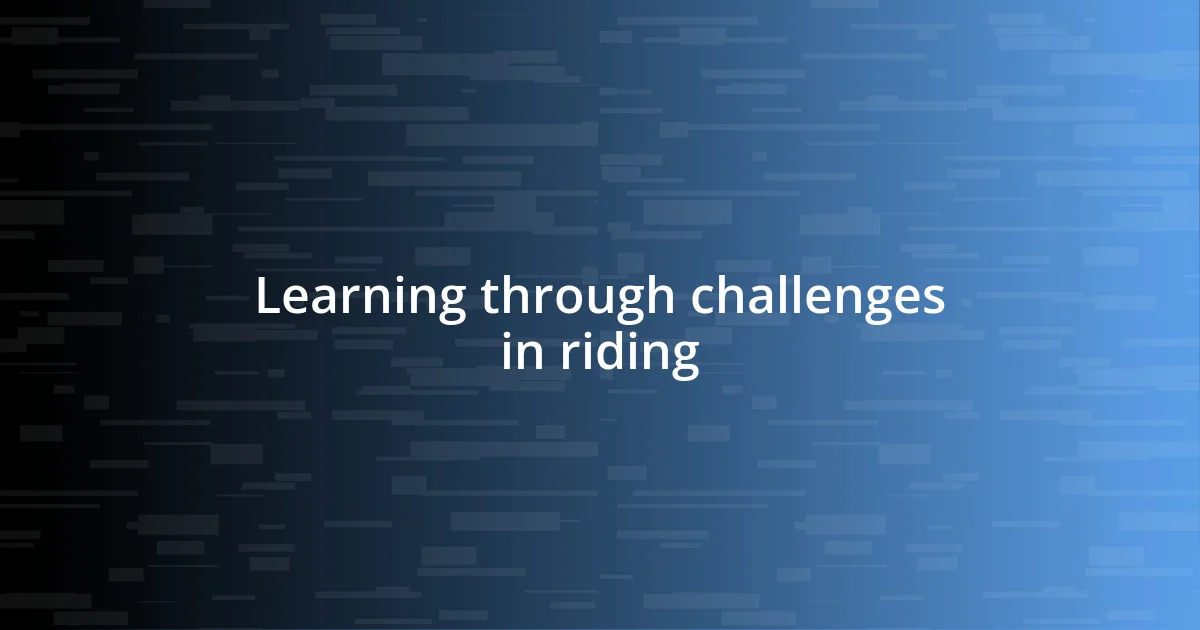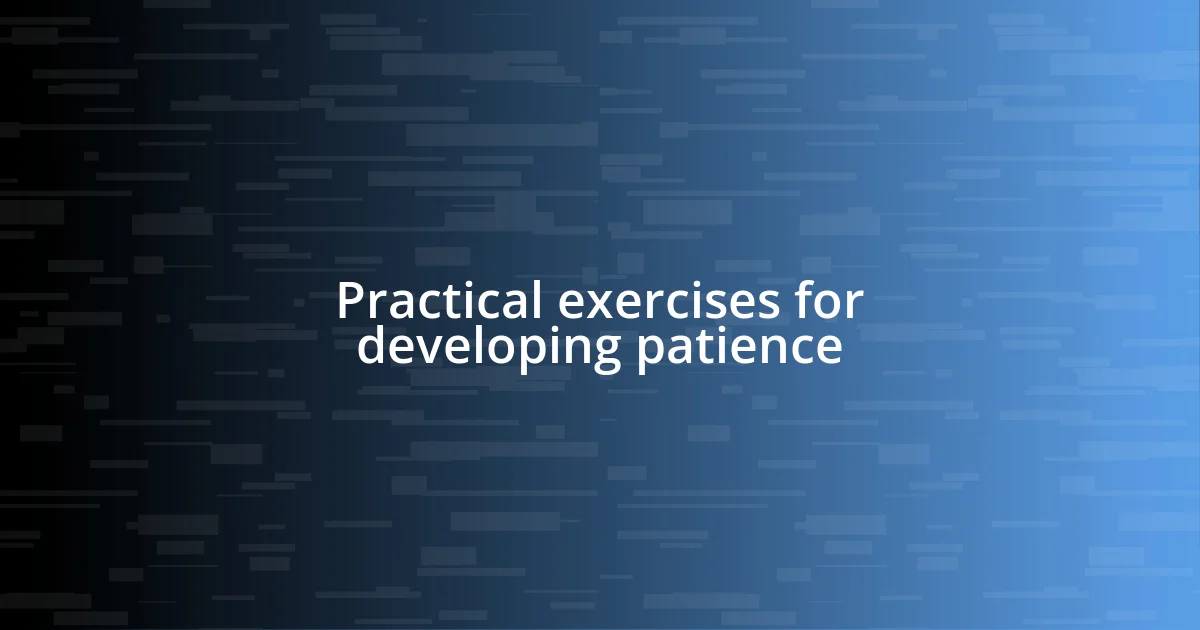Key takeaways:
- The journey of riding teaches the importance of patience, as progress is built on small, foundational steps that require reflection and trust.
- Challenges in riding, such as dealing with a hesitant horse, highlight how patience fosters confidence and composure, both for the rider and the horse.
- Techniques like mindful breathing, visualization, and journaling can effectively cultivate patience, enhancing both riding skills and life experiences.

Understanding patience in riding
When I first began riding, I often found myself frustrated with how slow progress could feel. I remember a particularly rainy day when my instructor had us work on simple transitions; I felt stuck, eager to move on to more exciting maneuvers. Looking back, I realize that those moments taught me the true essence of patience—every small step was a building block that laid the foundation for my riding skills.
There’s something about being on horseback that demands you to truly embrace the present moment. I recall a trail ride where my horse was skittish, and instead of rushing him forward, I chose to breathe and allow him to gain confidence. That experience not only deepened our bond but also drove home the point that sometimes the journey requires us to slow down and cultivate trust—not just in our horses but in ourselves too.
Have you ever noticed how impatience can lead to mistakes? I certainly have. I’ve learned the hard way that when I rush through a workout, it often results in frustrating setbacks. Now, I make a conscious effort to appreciate the rhythm of both my riding journey and my horse’s learning process, reminding myself that growth often requires a pause for reflection and understanding.

Learning through challenges in riding
Riding presents a myriad of challenges, each offering unique lessons in patience. I vividly remember a particularly challenging jumping lesson where my horse was hesitant to approach the jump. My instinct was to push him forward; however, when I realized that waiting a beat would allow him to find his confidence, we both benefitted. The moment he cleared that jump, I felt a surge of happiness—not just for the accomplishment but also for having embraced the challenge of patience.
In another instance, I faced a daunting situation during a dressage competition. My horse got rattled amidst the noise of the crowd, and I could sense my own tension rising. Instead of forcing him through the routine, I opted to calm myself first. By taking deep breaths and reassuring my horse with gentle words, we managed to complete the course gracefully. That day taught me the invaluable lesson that patience goes hand-in-hand with trust and composure—qualities essential for both rider and horse.
Reflecting on these experiences, I’ve come to appreciate that every challenge in riding, whether it’s overcoming fear or mastering a skill, mirrors the hurdles we encounter in life. In those moments of uncertainty, the decision to be patient and open to growth is what makes all the difference. It’s fascinating how these lessons learned from riding translate seamlessly into our everyday lives, offering a deeper understanding of ourselves and our capabilities.
| Challenge | Lesson Learned |
|---|---|
| Jumping lesson | Embrace patience to build confidence in both horse and rider |
| Dressage competition | Calmness and reassurance foster trust and composure |

Techniques for cultivating patience
Cultivating patience is like fine-tuning a skill that benefits not just your riding but life as a whole. One technique I’ve found immensely helpful is setting realistic goals. When I first started, I was eager to jump high and gallop fast. But now, I focus on mastering one small skill at a time. Break down larger objectives into bite-sized pieces. Celebrate those small victories along the way. It’s incredibly rewarding, and it keeps the momentum going without overwhelming me.
Here are some techniques to consider:
-
Mindful Breathing: Take a moment to breathe deeply, allowing yourself to reset. It calms not just you but also your horse.
-
Visualization: Picture success before you even attempt it. This mental practice prepares both you and your horse for what’s to come.
-
Journaling Progress: Keep a riding journal to reflect on your progress and setbacks. Writing it down helps clarify your journey and fosters gratitude for each step.
-
Practice Gratitude: Acknowledge what you’ve learned, even when progress seems slow. It shifts your mindset from frustration to appreciation.
-
Timeouts: Allow yourself breaks during practice. Stepping back can provide new perspectives on challenges you face.
In another instance, I remember pacing around the arena, feeling anxious about a particularly complicated maneuver. Instead of rushing in, I took a moment to step outside the ring. Watching other riders gave me fresh insights and erased the sense of urgency I felt. Returning with a clearer head, I attempted the maneuver and surprised myself—it worked! This experience taught me that sometimes, the best way to cultivate patience is to hit pause and allow time for clarity.

Real life rider stories
One day at the stable, I witnessed a fellow rider grappling with a stubborn pony. The pony refused to move, no matter how much she urged it. It was painful to watch her frustration grow, but then, instead of escalating her efforts, she sat quietly beside the pony, letting it take its time. After a few moments, the pony relaxed and began to move forward. That moment underscored for me how sometimes the secret lies in simply giving ourselves—and our horses—space to breathe.
Another memorable instance was during a trail ride with a group of friends. As we approached a steep hill, my horse became hesitant, sensing the challenge ahead. I felt the pressure to keep up with the others, but then I took a step back, literally and figuratively. I slowed down, patted my horse reassuringly, and spoke softly to him. As he gathered his courage and took that first step, I realized that patience isn’t just about waiting; it’s about supporting each other through the tough moments, building trust as we navigate life together.
I often find myself reflecting on those rides, especially during more intense moments in my life. Have you ever felt that same push to rush through a difficult task? It’s an easy trap to fall into, but every ride I take reminds me that true progress comes when I allow myself the grace to slow down. Just like on that hill, I’ve learned there’s beauty in patience, whether with our horses or in the hustle of life—each step taken together strengthens the bond and builds our resilience.

Practical exercises for developing patience
One exercise I truly appreciate is mindful breathing. There was this one particularly chaotic day at the barn when my horse was frantic. I could feel my own anxiety rising. Instead of diving into the chaos, I paused to take several deep breaths, inhaling slowly and exhaling fully. This simple act not only calmed me but also helped my horse find his center. Have you ever noticed how just a few deep breaths can change the energy in a room? It’s astonishing.
Another effective technique I recommend is visualization. I remember preparing for a big competition where I was feeling overwhelmed. In quiet moments, I would picture myself executing each phase of the course perfectly. This mental rehearsal not only stilled my nerves but also made the actual riding feel more familiar. Have you thought about how visualizing success can help you meet your goals? It’s a technique that shapes your reality and builds confidence.
Lastly, consider the power of reflective journaling. I’ve kept a riding journal for years, documenting my progress and challenges. It’s a therapeutic way to work through feelings of frustration and impatience. Each time I sit down to write, I remind myself of how far I’ve come—like the time I celebrated mastering a difficult technique after weeks of struggle. Looking back, it’s rewarding to trace those small steps that led to bigger achievements. Do you have a place where you capture your thoughts and feelings? It could be the key to unlocking further patience in your journey.














